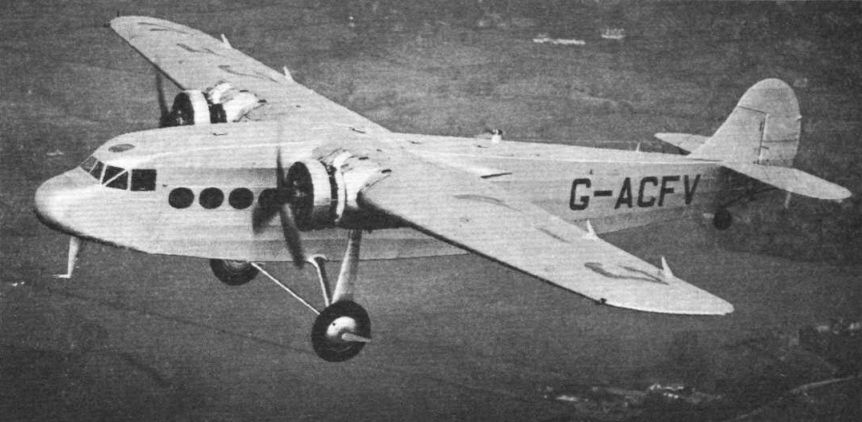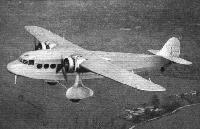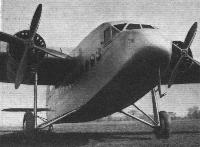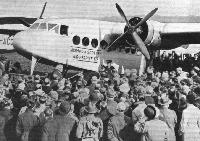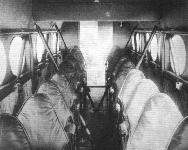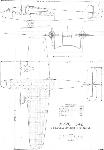Flight, September 1933
THE AVRO MONOPLANE
THE following brief notes regarding a new commercial aeroplane being produced by A. V. Roe & Co., Ltd., may be of interest.
The first machine in this new series of Avro commercial types is a somewhat larger aeroplane than the Avro Ten and is fitted with two geared "Jaguar" engines. Instead of making the top longerons of the fuselage continuous and attaching the wing directly thereto, A. V. Roe & Co. have adopted a modification, which was tried out very successfully in the Avro Six. At the point of attachment of the wing, the top longeron is dropped, so that the top line of the fuselage is continued in the upper surface of the wing instead of in the lower surface of the wing as before. This means that the spars pass right through the upper part of the cabin. The result of this alteration is to allow a reduction in the head resistance of the machine, while actually affording more head room for the passengers, the position of the spars in the cabin ci eating merely a momentary break in the general lofty appearance of the cabin.
In the present machine the two members of the crew will occupy a control room situated in the extreme nose of the fuselage and the flying controls will be very similar to those of the Avro Ten. Immediately behind this control room is the passengers' cabin, which is arranged on the machine at present building to accommodate sixteen passengers, with limited fuel range. It is probable that for normal commercial transport purposes the number of passengers will be reduced and the fuel range increased. The entrance door, lavatory accommodation and a rear baggage hold are all similar to the corresponding provisions made on the Avro Ten. The undercarriage, however, will be of the new Avro oleo type, in which rubber is not used at all. Either a tail wheel or a tail skid can be fitted, according to choice.
The engine mountings are attached directly to the front spar of the wing and are suitably streamlined into the aerofoil section by means of cowling and fairings. Each engine has a separate oil tank, mounted in the leading edge of the wing, and a separate fuel tank of welded aluminium, carried in a cradle between the front and rear spars of the wing.
No performance figures are yet available, but a very much better performance than that of the Avro Ten is expected.
Показать полностьюShow all
Flight, April 1934
AVRO 642 COMMERCIAL MONOPLANE
A development of the earlier Avro monoplanes, which should go a long way towards making commercial aviation a sound economical proposition
BUILT to the order of that northern air transport pioneer, Mr. John Sword, the Avro 642 is an extremely interesting aeroplane and a considerable advance on similar machines.
Chadwick, Avro's chief designer, has, despite the size of the 642, managed to provide excellent, positive and comparatively light controls. A short trial showed us that the 642 has not the characteristics of pronounced aileron drag, sluggish controls unharmonised as regards force required for operation, and similar undesirables often to be found in high-wing large monoplanes. Furthermore, the 642 does not float when landing, and when it is down it is, so to speak down, without there being any question about it. Naturally, being a clean job, its run is fairly long and fast, but it is by no means unduly so, and when the machine is loaded the brakes may be used to shorten the run as desired. The take-off is good, and we found no difficulty at all in holding the machine straight with one engine throttled back.
A glance at our table of performance figures, figures provided by the makers which are substantiated by official Air Ministry tests at Martlesham Heath, shows that the Everling High Speed figure is over 22. This is quite high for a twin-engined monoplane, and is a criterion of the cleanliness of design which has been achieved.
From the passengers' point of view, the 642 is good. The chairs are comfortable, and Rumbolds have made their usual excellent job of the interior upholstery. Mr. Sword has chosen a 16-seat layout with red imitation leather, relieved on the cabin walls with a red and grey brocade. This certainly has had the effect of making the cabin bright and cheerful. This effect is helped by the deep and well placed windows situated at the correct height for the passengers, so that they do not have to strain about when they wish to look out while sitting down. Naturally, with this number of passengers placed in two rows, there is not a superabundance of leg room, but the arrangement has a great advantage in that it gives every passenger a window seat - an advantage, the value of which it is impossible to calculate. It does seem a pity to us that this particular machine is not provided with windows that can be opened. This is always appreciated by passengers. Many times when travelling in large passenger-carrying aircraft we have noted how much they prefer to be able to get fresh air through a window when the cabin is a bit stuffy. True there is ample provision for fresh air through the usual individually controlled ducts, but this never seems quite the same as being able to get a draught directly through an open window. We understand that sliding windows can be fitted if required.
The fact that the cantilever wing, with its deep spars, is set right down on to the cabin means that the two spars take up a good deal of head room, but in the 642 this has been utilised to house the battery for the lighting, and other electrical equipment.
The passenger cabin is easy to get into, as a large step has been designed which folds up into the door space when the door is closed and can be let down at once when required after landing. At the rear end of the cabin there is a well-fitted lavatory, and aft of that again is the luggage compartment, while racks for light luggage run the lull length, each side, of the cabin.
The pilots' cockpit is separated from the main passenger cabin by a bulkhead and door, so that all draught is excluded, and the passenger cabin may, in cold weather, be adequately heated by the heating system, consisting of a hot air supply from a jacketed exhaust pipe.
The pilots' cockpit is well arranged, with full dual flying controls, centrally placed engine and wheel brake control levers and, a point which is not so common, the tail trimming wheel is fitted to the side of the throttle control lever mounting, so that either pilot can get at it easily. The usual range of instruments were on the dashboard, but, as in all large aircraft, this is a matter which differs with each owner. The windows around the pilots' cockpit are adequate in so far as forward and side view goes, but we felt that they could with good effect have been made deeper, especially in front. With the seats as they are, the unglazed part of the roof came too low for our liking, with the result that we were constantly bending down to increase the upward view. For the same reason we should have liked to see more cellon or glass in the cockpit roof. There was only one round cellon panel, which was hardly sufficient for absolute comfort when circling in to land. Possibly the model we tried was not completely finished, but as we saw it there was no provision for the pilot's maps, gloves and other small etceteras. No doubt weight and cost have to be cut in every way, but it seems a pity that the pilot should not be made really comfortable, because although he is non-productive as regards revenue, he has, after all, in this case the care of sixteen people on his hands.
The wheels and wheel brakes are the latest Dunlop types, and the latter make handling the 642 on the ground a simple matter. The central control lever, regulating the air pressure supplied to the brakes, is handily placed just below the throttle levers, and the pressure gauge unit is on the dashboard in front of the left-hand seat, where the chief pilot normally sits.
Each " Jaguar " engine is fed from an individual fuel tank of welded aluminium - normal capacity 97 gall. (440 l) - by dual engine-driven fuel pumps, through Petroflex tubing and the standard fuel filters. The tank cocks are controlled by levers situated on the cockpit roof above each pilot's seat. The engines are mounted on tubular welded steel mountings bolted to the front wing spars, with provision for carrying the torque loads back to the rear spars. Aluminium cowlings and Townend rings are used to keep the drag of the installation low, and the model under review had four-bladed wooden airscrews. The fuel tanks are mounted in the wing behind, and directly inboard of, each engine, and the oil tank is situated in front of it, forming a portion of the leading edge of the wing. A Kigass priming system is used and the engines are started by Siddeley Hand-Electric starters.
This article is mainly concerned with the 642 powered with two "Jaguar" engines, and the one which has just been delivered to Mr. Sword, in particular, but it should be noted that the same type can, if desired, be fitted with four Siddeley "Lynx" engines of 215 h.p. each. In this form the machine will have top speed at sea level of 150 m.p.h. (241,4 km/h) and a cruising speed of 127 m.p.h. (204,4 km/h), while the passenger accommodation then becomes twelve, for a range of 400 miles (643,7 km). Our table gives the maximum range of the "Jaguar" engined model for varying passenger loads when fitted with the standard fuel tanks, a lavatory and large baggage hold; it should be noted that the range can be increased by reducing the number of passengers and increasing the fuel tankage, at the rate of 60 miles cruising range per passenger.
Liberal instrument equipment is provided as standard and items like a Turn and Bank Indicator, Compass, Clock, and all the usual flying and engine instruments are included in the specification.
Coming now to structural considerations, it will be seen that in general the 642 is similar to the earlier Avro monoplanes and that qualities like economical maintenance and long life have, in particular, been retained.
The wing is basically like the Avro Ten, the boxed plywood and spruce spars being continuous from tip to tip. The ribs are also built up of plywood and spruce and, from the rear spar forward the wing is completely plywood covered; moreover, this plywood has fabric glued over it as a final and lasting weather protection. Aft of the rear spar the wing is made in the form of a detachable section and is fabric covered; this is done so that transportation of the large wing may thereby be simplified.
The ailerons, of the Frise balanced type, are long and have a narrow chord. They are, like the wing, of spruce construction with a plywood leading edge and fabric covered. Both the ailerons and the tail control surfaces are operated through a tie rod system which incorporates flexible cables running over pulleys where necessary, thus obviating the use of rubbing contacts on blocks of fibre.
All the tail unit surfaces are of welded steel tube construction with doped fabric covering. The elevators have horn balances of the inset type while the rudder is balanced by means of a small auxiliary surface inset in the trailing edge, hinged to it and controlled by a lever fixed to the fin. The tail plane is adjusted to trim the 642 through non-reversible screw gearing acting on the rear spar and operated by a wheel in the pilots’ cockpit.
The fuselage is a single unit of welded steel tubes. In some cases the bracing is by diagonal tubes, in others by steel wires. The tubes used are of specification, D.T.D.89a, and are hermetically sealed, thus obviating any possibility of internal corrosion.
The floor of the cabin is particularly rigid and strong and replaces the diagonal bracing, in a horizontal plane, of the bottom of the fuselage. Each section is built up of spruce and plywood and can carry a load of 100 lb./sq. ft. (488 kg/m2). The walls of the cabin are lined with soundproofing material and panelled with plywood. The outside of the cabin is fabric covered. The pilots' cockpit is a separate unit of wooden construction bolted to the front of the fuselage.
Straightforward, simple and robust, sums up the undercarriage. Each side is a separate unit consisting of an axle hinged to the bottom longeron, a shock-absorbing strut carried up to wing which takes the landing loads through an oleo cylinder and the taxying loads through a system of spiral steel springs ; a radius rod in tension, being led forward of the axle forms the rest of the unit. The Dunlop wheels carry high-pressure tyres and streamline fairing can be fitted over them if required.
As we have already indicated the 642 has been designed as a commercial aeroplane in the fullest sense of the word. It is only natural, therefore, that matters affecting maintenance should have received the most careful consideration. It will be found that, for example, all lubricating points are easily accessible and fitted with grease-gun nipples. The fabric covering of the fuselage can readily be opened for inspection purposes, and wherever necessary sliding panels are provided. Furthermore, the Avro system of construction is of the kind which permits repairs, to be performed without the necessity of, elaborate workshop equipment. The wing is a straightforward matter and can be dealt with by any skilled carpenter, when he is shown how. The fuselage can be repaired either by welding or by an approved system of sleeving which has been evolved.
In a word, the 642 should prove in service to be a thoroughly practical, economical and efficient aeroplane.
Показать полностьюShow all
